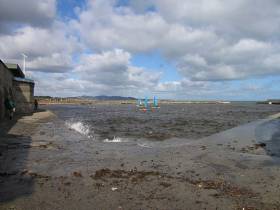Displaying items by tag: Bray Harbour
#BrayHarbour - Bray Harbour has lagged behind its more illustrious Co Wicklow neighbours, from Wicklow Sailing Club and its annual Round Ireland Race to neighbouring Greystones and its successful new marina.
A build-up of silt in the harbour similar to that plaguing Howth boaters hasn't helped matters.
But moves are being made to boost Wicklow's closest harbour to the capital, from the water to the quayside, as the Wicklow Times reports this week even though some Bray locals think real work in the harbour still lies over the horizon.
Speaking at the launch of Bray Sailing Club's 2016 summer season, Wicklow County Council cathaoirleach Cllr John Ryan promised to work with the OPW to implement a lasting solution to the silt deposits as part of a new strategic plan for the harbour but Bray Sailing club Commodore Mark Henderson says they are still a 'long way from seeing anything happen to improve the situation'.
'The tragedy is that we have a vibrant and growing sailing club with over 300 members in a prime location beside a harbour which is rapidly becoming unusable' Henderson told Afloat.ie
'Many moorings are now severely restricted in their use due to increased silting, while others are untenable in even moderate weather conditions because of breaking waves. This has led to many club members moving their boats elsewhere, and frequent launching difficulties for our (dry sailed) Flying Fifteen fleet, says Henderson.
'We as a club, along with other organisations representing approximately 800 to 900 harbour users, are working hard to have something done before the harbour becomes totally unusable but to date we are frustrated that we are able to report little progress' he says.
He also backed investment to support upgrades already made in the harbour area, such as the refurbishment of the Harbour Bar and the new Dockyard restaurant.
Imminent improvements include the opening of a new walkway along the Dargle River in the North Co Wicklow town.
Screening Shown of Unique Lives Lost at Sea Ceremony
#MARINERS WITH MEMORIES – At the weekend representatives of the maritime community, relatives and visitors alike attended a screening of the 'Mariners with Memories' ceremony, which was shown in the Maritime Museum, Dun Laoghaire.
The ceremony which took place in Bray Harbour last July, is unique in that it recognises to all those lost to sea throughout the world and especially to those whose grave is the sea.
Shot by Colm Fynes, the film documented the day's proceedings with tributes made at the Co. Wicklow harbour and the flotilla that followed with floral tributes carried out close to the shore.
Captain Tony O'Grady who organised the Mariners with Memories ceremony, thanked all those to the museum and the support of the Maritime Institute of Ireland, whose newly renovated museum was a particularly apt venue, being the former Mariners Church.
Some of the relatives who attended the memorial event in Bray were also at the Dun Laoghaire screening and where they gave moving tributes to loved ones.
Commenting on the poignancy of the screening, Captain O'Grady referred to the on-going tragic events in Glandore Harbour and off the Italian island of Giglio.
He added that those involved in the various services off the West Cork fishing harbour would of liked to have attended but given the circumstances, all the resources were required at the scene.
It is hoped that following the inaugural ceremony, that Mariners with Memories will become an annually held event and the close relationship with the museum continues.
The museum which was especially opened for the screening will remain closed throughout the winter months though is open on an invitation only basis. Officially the museum is due to re-open this Easter, to keep posted of further developments visit www.mariner.ie
Screening to Mark ‘Mariners with Memories’
#MARITIME MUSEUM - A video recording of the 'Mariners with Memories" wreath-laying ceremony held at sea off Bray last year, is to take place tomorrow afternoon (at 14.30) in the maritime museum in Dun Laoghaire.
The ceremony which was held on 30 July involved a flotilla off Bray Harbour where floral tributes were made to commemorate all those lost at sea especially those whose last resting place is the sea which claimed their lives.
In addition the video presentation will also mark the 70th anniversary of the formation of Irish Shipping Ltd in 1941 and the founding of the Maritime Institute of Ireland (M.I.I.) which was also established in that year.
Copies of the D.V.D. will be available on request R.S.V.P. to this email: [email protected]
The institute aims are to foster an appreciation of the nation's maritime heritage and the museum which is located in the former Mariners Church. The museum has been closed for several years due to essential renovation, though is open on an invitation only basis during this winter. It is due to be officially re-opened in Easter of this year.
Activities of the M.I.I. (which is open to members) include running a winter/spring lecture programme, newsletters, a library, research and the hosting and supporting of commemorations.
For more information including how you can support them as a volunteer click HERE
Those participating are asked to assemble at the Hibernia Inn (near Bray Dart Station) from 13.00 hours. At 14.00 hours, an anchor shaped wreath will lead the procession of wreaths to the north Bray pier-head where a memorial service will be held, at which representatives of those in attendance will be invited to speak.
This will be followed by one minute's silence after which, those accompanying the wreaths will embark on the flotilla to a position approximately five-cables due east of Bray Harbour.
Anyone who would like to assist in the preparations and to remember those who have been lost are invited to attend. For further information, contact Tony O'Grady, Captain, (retired) on behalf of "Mariners with Memories" on Tel: (01) 276 0575 Mob: 087 245 4071 Email: [email protected] in addition to this LINK.
































































